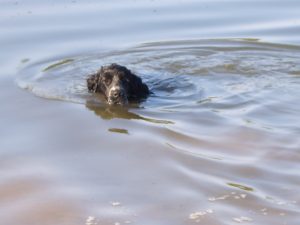Can All Dogs Swim?
Swimming is a great way for dogs to cool down in hot weather and it is also good exercise too – especially for those recovering from injury. But, do all dogs know how to swim? Holidays4Dogs investigates.
Many people may assume that all dogs have an innate ability to swim in the same way they have natural instincts to dig, or bark. Surprisingly, however, not all dogs can swim and some just don’t enjoy being near water full stop. Others, while wary of water at first, may learn to swim and will relish any opportunity to paddle away to their hearts content. Many dogs have webbed feet which give them a distinct advantage when it comes to being natural swimmers.
It often depends on the breed as to whether you end up with a canine water baby. Labradors, spaniels and Newfoundland’s are definitely more inclined to be natural swimmers and often it is difficult to keep these breeds out of the water – even in winter.
You should always take into account your dog’s breed, age and ability when your take your dog swimming. Swimming can be very exercise for dogs as it is very low impact. Dogs suffering with arthritis, for example, can benefit from gentle swimming sessions in a canine hydrotherapy pool.
Buoyancy and ballast.
 Other breeds such as bulldogs and pugs find swimming physically difficult. They tend to find the effort of propelling themselves through water very tiring, due to their shortened faces. In fact, many breeds like pugs should be carefully watched around water. Other breeds, such as dachshunds, with their short little legs can find it a challenge to swim. Generally speaking, aren’t natural water lovers.
Other breeds such as bulldogs and pugs find swimming physically difficult. They tend to find the effort of propelling themselves through water very tiring, due to their shortened faces. In fact, many breeds like pugs should be carefully watched around water. Other breeds, such as dachshunds, with their short little legs can find it a challenge to swim. Generally speaking, aren’t natural water lovers.
Heavier breeds such as basset hounds also find swimming difficult, not least because they carry two thirds of their weight at the front of their bodies. At very least, this makes for an interesting swimming style, but it can be dangerous if they have difficulty keeping their head end from submerging.
French bulldogs are a very popular breed nowadays and their appeal is widespread, but these dogs do not make good swimmers for similar reasons. Their barrel shaped bodies are dense and, along with short legs and difficulty breathing, it is sensible to always monitor them near deep water.
Dipping the toes.
Other dogs may well be capable of swimming, but are simply not attracted to the idea at all. My collie is a point in case. She may occasionally paddle her feet in the sea, but water of any kind seems to frighten her. She doesn’t even like going out in the rain, let alone swimming. As for bath time…
 Going swimming with your dog, either in an outdoor pool, river, or sea is a lovely bonding experience. However, it’s better to accustom your dog to swimming gradually. Never throw your dog into water as this is quite like to put him off permanently. The best idea is to use a floating toy and encourage him into the water gradually. He is much more likely to enjoy the experience if he can get used to the water at his own pace.
Going swimming with your dog, either in an outdoor pool, river, or sea is a lovely bonding experience. However, it’s better to accustom your dog to swimming gradually. Never throw your dog into water as this is quite like to put him off permanently. The best idea is to use a floating toy and encourage him into the water gradually. He is much more likely to enjoy the experience if he can get used to the water at his own pace.
Conclusion.
Swimming can be great fun for dogs, especially during hot weather, but do consider water quality. Blue-green algae found in lakes and ponds can be fatal to dogs. Leptospirosis is also a nasty disease carried by rat urine and ingested in water. Always avoid, slow moving water or stagnant ponds where bacteria can thrive.
When it comes to swimming, or water sporting activities, dogs will either love it – or hate it. If your dog is not a natural water puppy, just be thankful you won’t have to put up with that wet dog smell on the way home in the car.


